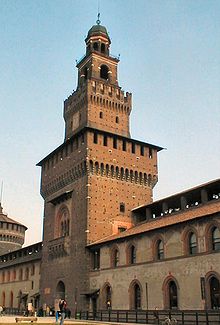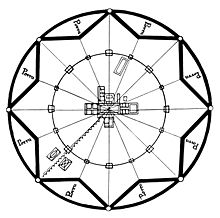Filarete
Filarete , actually Antonio di Pietro Averlino (* around 1400 in Florence , † around 1469 in Rome ?) Was an Italian sculptor , medalist , engineer , architect and architectural theorist of the Renaissance ; Averlino gave himself the Greek name Filarete (good friend).
biography
Filarete was probably born in Florence and began his artistic career there, possibly in Ghiberti's workshop . He received his first commission as a sculptor from Pope Eugene IV , for whom he built a bronze portal for Alt-St. Peter , which was later integrated into the new building of St. Peter as the main portal . After a stay in Florence (1448) and Venice , he was called to Milan by Francesco Sforza on the recommendation of Piero di Cosimo de 'Medici . Filarete played a key role in his ambitious project to redesign Milan’s urban development. Filarete's stay in Milan was only interrupted by two construction projects in Bergamo and Venice . Little of his plans was carried out, but his building drafts and his architectural treatise are of particular importance for Renaissance architecture and Baroque urban planning.
plant

Filaretes Trattato d'architettura (Architectural Treatise ) in 25 volumes was written between 1460 and 1464. It is dedicated to Piero de 'Medici. The ideal city of Sforzinda is described in the literary form of an allegorical novel . The city is equipped, among other things, with peculiar buildings, such as a ten-story tower of virtues and vice - a brothel - with an observatory on the top floor. In addition, questions relating to the equipment and decoration of houses, building materials, the use of construction machinery and the usual construction techniques of the time are discussed, as are fundamental questions of engineering and fortification construction . The book was distributed in transcripts and was first printed in the 19th century.
Vasari mocks the book, believing it to be one of the stupidest books ever written. Alberti's satire Speculum Principis may be directed against Filarete's treatise. Today's classification is much more positive: Filarete's merit is the introduction of construction plans that describe the building in its entirety. This fundamental innovation compared to medieval construction practice makes the construction method of a building comprehensible; construction can also take place in the absence of the master builder. Filarete also differs from Brunelleschi , who developed all parts of the building from geometric shapes.
A city designed on the basis of his ideal plans is Palmanova in the Friuli-Venezia Giulia region .
literature
- Peter Tigler: The architectural theory of the Filarete . Berlin 1963.
- Filarete, Trattato di architettura , ed. Anna Maria Finoli and Liliana Grassi. Il Polifilo, Milan 1972.
- Michele Lazzaroni, Antonio Muñoz: Filarete: scultore e architetto del secolo XV . W. Modes, Rome 1908.
- Filarete . In: John R. Spencer (translator): Treatise on Architecture . Yale University Press, New Haven 1965.
- Gernot Michael Müller: Architectural Theory m Dialog. Antonio Filarete: Libro architettonico, 1464 . In: Dietrich Erben (ed.): The book as a draft. Text genres in the history of architectural theory. A manual , Paderborn: Fink 2019, ISBN 978-3-7705-6334-0 , pp. 58-91.
- Berthold Hub: Filarete. The Renaissance Architect as Demiurge and Pedagogue , Vienna: Böhlau 2018 (Studies on Art History; 2), ISBN 978-3-205-20724-5 .
Web links
- Literature by and about Filarete in the catalog of the German National Library
Individual evidence
- ^ L. Forrer: Biographical Dictionary of Medallists . Averlino or Averulino, Antonio, surnamed Filarete. tape 1 . Spink & Son, London 1904, p. 93 .
- ^ L. Forrer: Biographical Dictionary of Medallists . Filarete, vide Averlino Antonio. Volume II. Spink & Son, London 1904, pp. 92 .
- ^ L. Forrer: Biographical Dictionary of Medallists . Filarete. tape 7 . Spink & Son, London 1923, p. 302 ff .
| personal data | |
|---|---|
| SURNAME | Filarete |
| ALTERNATIVE NAMES | Averlino, Antonio (maiden name); Averlino, Antonio di Pietro; Averulino, Antonio |
| BRIEF DESCRIPTION | Italian sculptor, engineer, architect and architectural theorist of the Renaissance |
| DATE OF BIRTH | around 1400 |
| PLACE OF BIRTH | Florence |
| DATE OF DEATH | around 1469 |
| Place of death | Rome |


